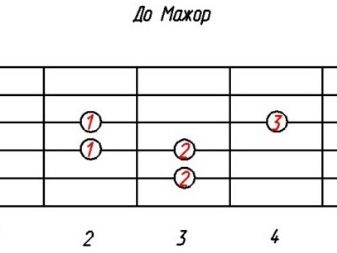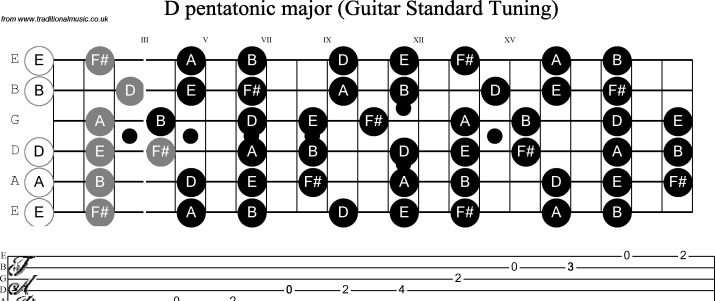What is pentatonic scale on the guitar and how to play it?

Novice instrumentalists who study music seriously (in musical educational institutions or with literate private teachers) and study all the related disciplines attached to the main course, practically from the first theoretical lessons they learn that there are 2 types of scales: major and minor. And each of the scales contains 7 sounds, successive in height. For example, in the one-octave scale of C major, the sounds are arranged in the following sequence: Do-Re-Mi-Fa-Sol-La-Si, and then the same sequence of sounds begins again, but in a different octave, higher. The same thing happens in the A minor scale: La-Si-Do-Re-Mi-Fa-Sol-La. However, at the stages of studying musical literacy and elementary music theory, students are not given any information about such a type of scales as pentatonic scale. It is about her that we are talking about in this article.


What is it and what is it for?
Pentatonic scale consists of sounds of the same classical minor or major scale, but 2 scale steps that create a semitone interval in the diatonic scale (and are not included in the main triad) are excluded from the pentatonic sequence.
Thus, in the A minor scale, the pure sounds C and F are not included in the pentatonic scale. The same sounds are absent in the pentatonic sequence built on the basis of C major.


It is not known exactly which of the musicians and when was the first to use this mode for composing new music, improvisation, or for fantasies on the theme of existing works. Now only the drummer does not play the pentatonic scale, since he cannot extract musical sounds - only percussion (noise, without a certain pitch).But most musical researchers still tend to believe that the pentatonic scale is most likely a guitar "trick" invented by blues guitarists, since the blues itself is built precisely on pentatonic improvisations and melodies. This reduced fret is most convenient for playing the guitar. - it allows you to come up with, one might say, on the go more and more solo parts and polyphonic sounds. This is exactly what the pentatonic scale on the guitar is for: for convenient improvisations, beautiful solos and unusual chords.

How is it built?
As with the classical scales, there are 2 types of pentatonic scales: major and minor. And pentatonic scales are built on the basis of the corresponding diatonic sequences of musical sounds. It is most convenient to consider this using the example of C major and the parallel A minor.
For a better understanding, let us first consider the classical sequences of sounds: in major - from the note C, in minor - from the note A.

In the C major scale, between the III and IV steps (notes E and F), as well as between the VII and I steps (notes C and C), the pitch intervals are semitones. In the A minor scale, the sounds are the same as in C major, but they are arranged in a different order (starting with the note A). Therefore, of course, semitone intervals remain between the same pairs of sounds (Mi-Fa and Si-Do), but only now they have completely different step numbers:
- the Mi and Fa notes are the V and VI steps, respectively;
- notes C and C - II and III degrees, respectively.
In the pentatonic scale, there are no semitones between adjacent sounds (they are eliminated by excluding 2 steps). These steps are (as we just found out):
- in major pentatonic scale - IV and VII degrees;
- in minor pentatonic scale - II and VI degrees.
Naturally, from the two pairs of sounds in each fret, we removed those that are not included in the tonic triads (the main chords of the fret). In our example (parallel scales in C major and A minor), the sounds F and C were removed. Therefore, the pentatonic C major and A minor sequences are as follows.


The image shows the steps removed from the classical scales in C major and A minor (crossed out sounds), and what remains is just the pentatonic sequence of these modes.
According to this scheme, you can compose and play the pentatonic scale in any necessary major or minor scale, removing unnecessary sounds from it at the corresponding step numbers.

Boxes
For the convenience of playing and improvisation, guitarists have developed the so-called pentatonic boxes, which are a sequence of sounds of one or another pentatonic scale, not exceeding the limits of 4 or 5 frets, on all 6 strings of the guitar. These boxes are often represented graphically in teaching materials: on a schematic representation of a guitar neck with frets and strings. The places where the strings are pressed in such diagrams are indicated by circles, sometimes multi-colored, to highlight the tonic sound or auxiliary notes used in improvisation.

There are 5 pentatonic fingering positions. Below are graphical diagrams of these positions. On the diagrams, colored circles indicate tonic sound. In this case, the minor pentatonic scale from the sound G (G) is considered.






It should be noted that pentatonic boxes obey the well-known chord system called CAGED, that is, by moving one or another pentatonic box fingering along the neck of the guitar, they get a different key.
For example, the boxing of any position above the indicated G minor pentatonic scale can be easily translated into A minor: for this you need to either move the entire fingering or part of it from the tonic sound to the right along the fretboard by 2 frets (increase by 1 tone).

The second feature of boxes is that the principle of parallelism of keys is valid for them.... This means that the pentatonic range of sounds of any A-minor box is also valid for a major parallel to it.In other words, the pentatonic A-minor boxing fingering is perfectly suitable for playing the C major pentatonic scale. The same rule applies to all other parallel major-minor pairs.

In addition, there is the concept of blues pentatonic scale, which is characterized by the presence, based on the minor pentatonic sequence, of one or more so-called blues notes.
In A minor fingering, this is usually the note E flat (lowered fifth). It turns out that the sixth sound appears.

How to play correctly?
For aspiring guitarists, it will be helpful to learn how to play the pentatonic scale correctly. Here are some tips from the pros.
- First of all, you need to study all 5 positions of the pentatonic fingerings. This will help you to quickly memorize the location of the notes on the guitar fretboard, as well as develop your hearing aids. It is also recommended that you sing the notes you play out loud.
- It is better to start learning to play with the A minor pentatonic scale. In front of you you need to have either a boxing scheme, or notes, or tabs, so as not to be mistaken.
- The pentatonic scale is played like this: start with the first sound on the sixth string and move sequentially to the last note on the first string in an upward movement.... In this case, the specified fingering is strictly observed. Fingers cannot be changed. Further, it is necessary, without interrupting the game, to return back to the original sound on the sixth string in a downward movement.
- If you play an electric guitar with a pick, then you need to play with a variable stroke: the first sound is a downward strike, the second is from the bottom up, and so on, changing the direction of the pick with each sound.
- On a classical guitar, scales are usually performed with 2 fingers alternately... But it would be better if there were several options, for example: i-m, m-a, m-i, a-m. Let all fingers develop in the same way.
On the bass guitar, you should play the pentatonic scale according to your schemes (also in 5 positions), presented in the images below. It may be necessary to continue the scale if the guitar will not have standard 4 strings, but 5 or even 6 strings. On the bass, you need to practice playing scales with both your fingers and a pick.










